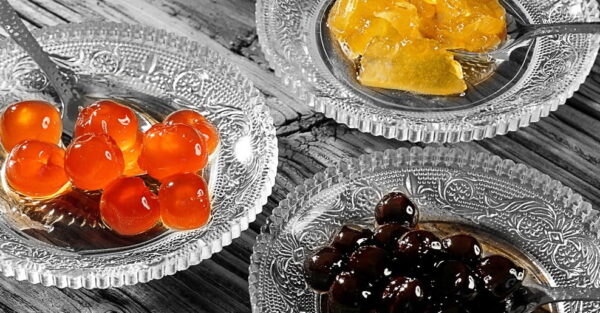Spoon sweets are sweet preserves, served on a spoon as a gesture of hospitality. They can be made from almost any fruit, though sour and bitter fruits are especially prized.
Some of the fruits that are used include seedless grapes, mulberries and other berries, bergamot, apricots, apples, pears, sour and sweet cherries, oranges and kumquats, lemons, grapefruit, tangerines, pomegranates, quinces, figs, prunes, and others.
Even soft fruit like melon or watermelon can be thus prepared, although ensuring a relatively firm texture is a challenging task. Other varieties include green unripe walnuts, pistachios, hazelnuts, and other nuts, or even flower petals like rose. Many fruits or parts of fruits that are normally inedible, such as citrus peels and blossoms, or sliced citrus fruits with their peel intact, can be made into sweet, flavorful preserves, as can some vegetables such as baby eggplants or cherry tomatoes. A well-made spoon sweet retains the original shape, color, aroma and taste of the fruit.
Spoon sweets are usually offered to guests served by the teaspoon in a small porcelain or crystal glass dish or bowl, with coffee or tea and cold water. Most of the time they are homemade, but nowadays they can also be easily found in most supermarkets; these are more likely to be made with glucose syrup rather than sugar, for reasons of cost and ease of preparation.
They can be used as ice cream or yogurt topping, or in the Western way as a spread on toast for breakfast. Spoon sweets are commonly eaten alone or the most often with the Greek coffee.
Photo: cretanhoney.gr




